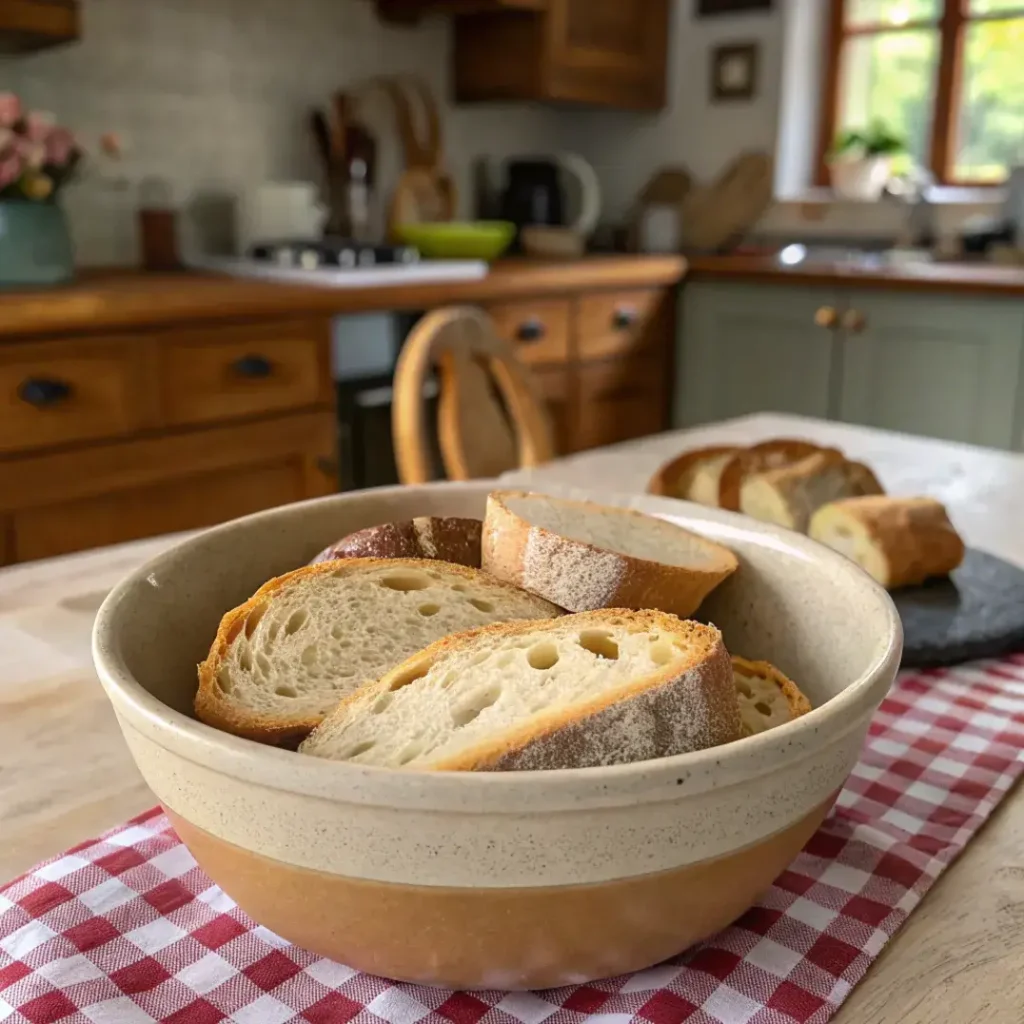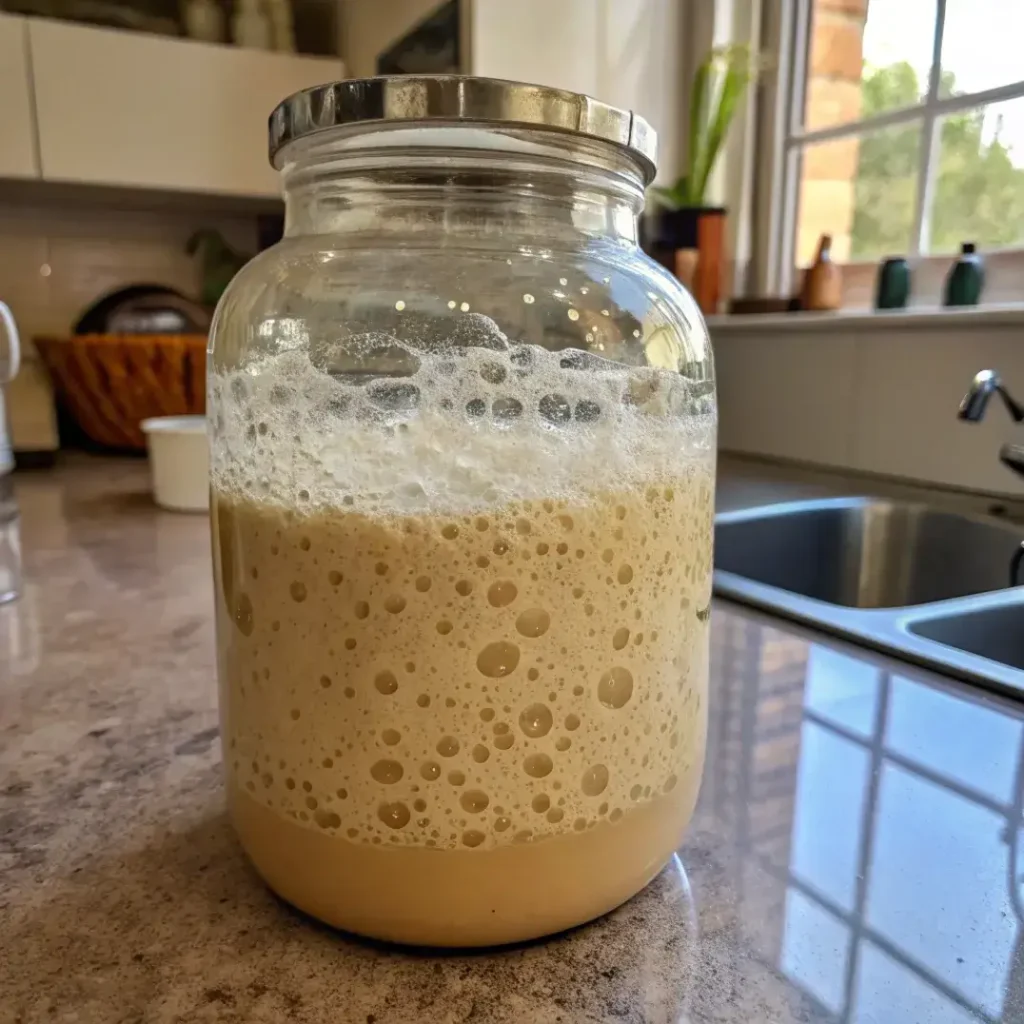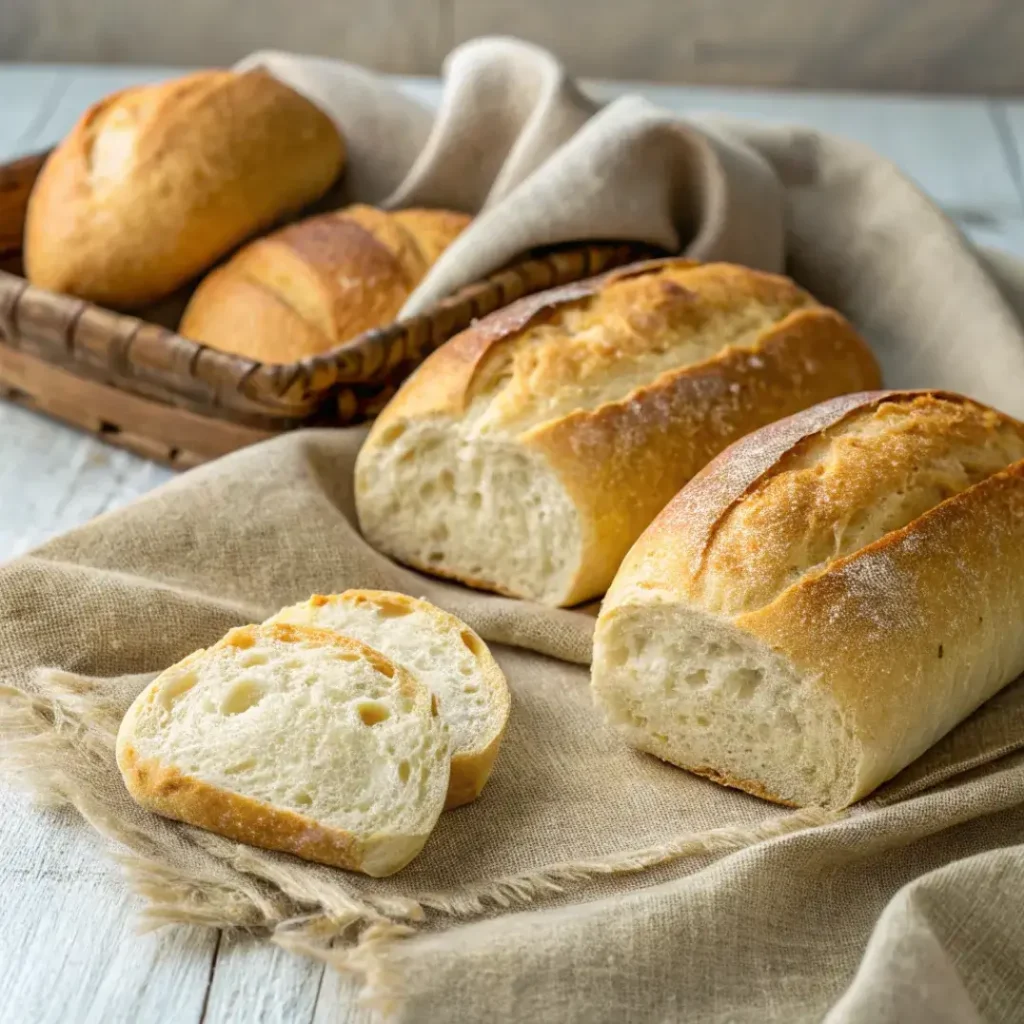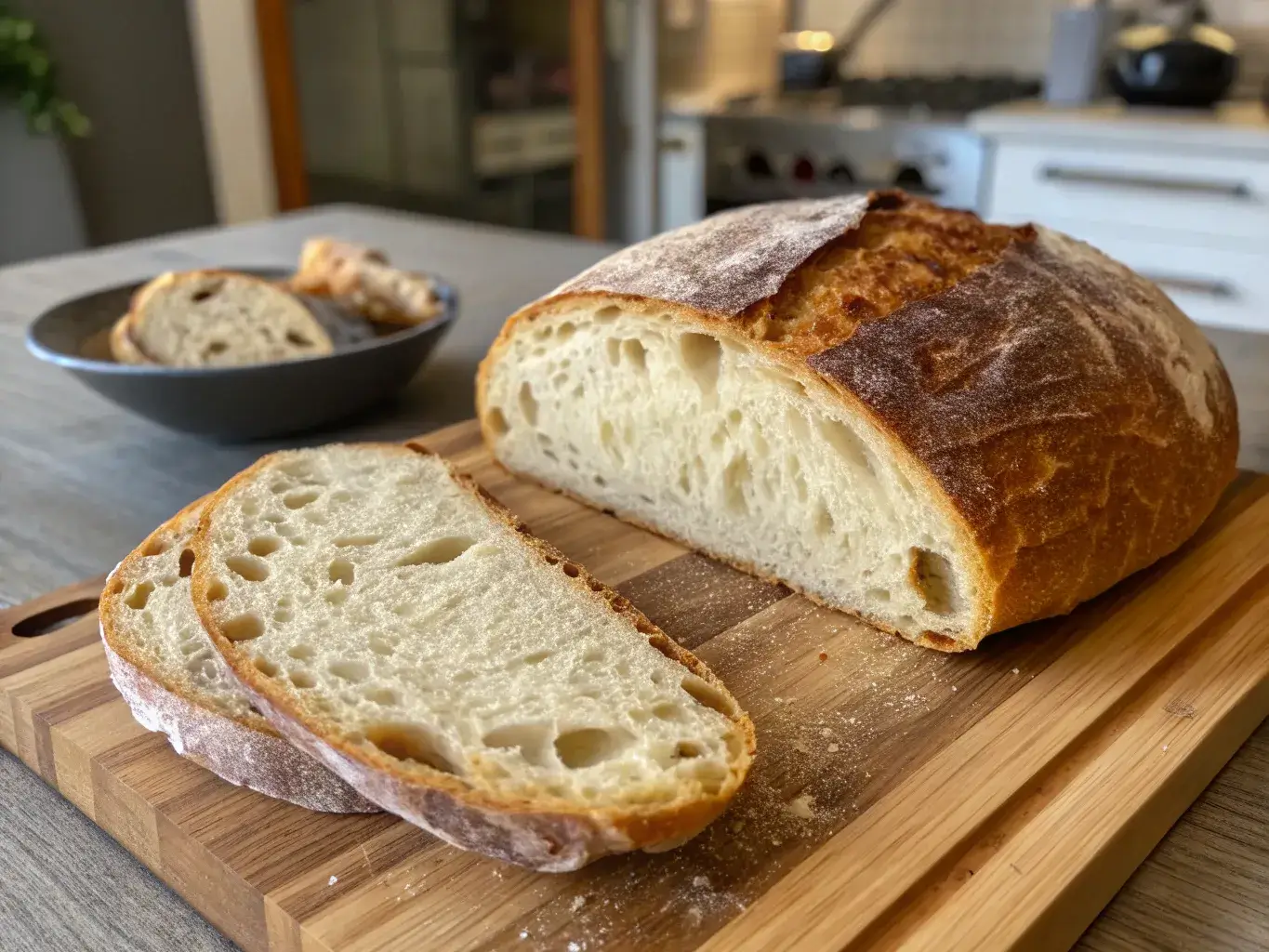Is sourdough bread gluten free? At Recipes of Kitchen, The Gluten-Free Sweet Kitchen, I get asked this often. I’m Lidia Bellacci, and my journey into gluten-free baking began when I discovered my gluten sensitivity. What started as a struggle soon became a passion for creating recipes that are safe, delicious, and satisfying.
In this guide, we’ll explore what gluten is, how sourdough fermentation changes it, whether sourdough is safe for gluten intolerance, and which breads truly have the least gluten.
Understanding Sourdough Bread and Gluten
What Makes Sourdough Different from Regular Bread
- Natural Fermentation
Unlike commercial bread that uses packaged yeast, sourdough relies on a live starter made from flour and water. This starter collects wild yeast and beneficial bacteria from the environment. - Longer Preparation Time
While commercial bread can be ready in just a few hours, sourdough often requires 12–24 hours of fermentation. - Gluten Development
During the resting phase called autolyse, gluten proteins begin to activate. Kneading, stretching, and folding strengthen this gluten network, giving sourdough its chewy texture. - Unique Flavor and Texture
The slow fermentation process creates sourdough’s tangy flavor, airy crumb, and crisp crust, setting it apart from regular bread.

Is Sourdough Bread Gluten Free?
- Total Time: 6–8 hours (including rise time)
- Yield: 1 loaf 1x
Description
A rustic and flavorful gluten-free sourdough bread made with a gluten-free starter and a blend of wholesome flours.
Ingredients
1 1/2 cups active gluten-free sourdough starter
2 cups warm water
3 cups gluten-free flour blend (with xanthan gum if not already included)
1 cup sorghum flour
1/2 cup brown rice flour
1/4 cup ground flaxseed
2 tsp salt
1 tbsp olive oil
Optional: 1 tbsp honey or maple syrup for slight sweetness
Instructions
1. In a large mixing bowl, combine the gluten-free starter and warm water. Stir until fully mixed.
2. Add the gluten-free flour blend, sorghum flour, brown rice flour, and flaxseed. Mix until a sticky dough forms.
3. Stir in the salt and olive oil (and honey if using), mixing thoroughly.
4. Cover the bowl with a clean towel and let the dough rest at room temperature for 4–6 hours, or until noticeably risen.
5. Lightly oil a loaf pan or line it with parchment paper. Transfer the dough into the pan and smooth the top.
6. Allow the dough to rise again for 1–2 hours until slightly puffed.
7. Preheat your oven to 425°F (220°C). Place a small oven-safe dish of water on the lower rack for steam.
8. Bake the bread for 45–50 minutes, or until golden brown and firm to the touch.
9. Let the bread cool completely before slicing to ensure the crumb sets properly.
Notes
For best results, use a mature and active gluten-free sourdough starter.
You can experiment with different gluten-free flours, such as millet or buckwheat, for varied flavor and texture.
This bread keeps well for 3–4 days in an airtight container, or slice and freeze for longer storage.
- Prep Time: 20 minutes
- Cook Time: 50 minutes
- Category: Bread
- Method: Baking
- Cuisine: Gluten-Free
Nutrition
- Serving Size: 1 slice
- Calories: 120
- Sugar: 2g
- Sodium: 210mg
- Fat: 3g
- Saturated Fat: 0.5g
- Unsaturated Fat: 2g
- Trans Fat: 0g
- Carbohydrates: 22g
- Fiber: 3g
- Protein: 4g
- Cholesterol: 0mg
Keywords: gluten-free sourdough, sourdough bread, gluten-free bread
How the Fermentation Process Affects Gluten Content
- Partial Gluten Breakdown
Fermentation reduces some gluten proteins, making sourdough easier to digest for certain people. - Phytic Acid Reduction
Natural bacteria in the starter break down phytic acid, an anti-nutrient that can block mineral absorption. This boosts your body’s power to soak up essential nutrients like iron and zinc, helping you feel more energized and nourished. - Lower but Not Zero Gluten
If you’re wondering, is sourdough bread gluten free? The answer is no, at least when it’s made with wheat, rye, or barley flours. Even after long fermentation, gluten levels remain above the safe threshold of 20 parts per million (ppm). - Safer Only with Gluten-Free Ingredients
The only sourdough that qualifies as gluten free is baked using certified gluten-free flours and a gluten-free starter.
Sourdough vs Regular Bread
| Feature | Traditional Sourdough Bread | Regular Commercial Bread |
|---|---|---|
| Leavening Method | Natural fermentation with starter | Packaged commercial yeast |
| Preparation Time | 12–24 hours or more | 2–3 hours |
| Gluten Content | Lower than regular bread but not gluten free | High gluten content |
| Digestibility | Easier for some due to fermentation | Often harder to digest |
| Nutrient Absorption | Improved by reduced phytic acid | Lower, due to less fermentation time |
| Flavor and Texture | Tangy, chewy, airy | Mild flavor, often softer |
Is Sourdough Bread Gluten Free by Nature
Why Sourdough Still Contains Gluten
- Made with Gluten-Containing Grains
Traditional sourdough is usually made from wheat, rye, or barley flours. All of these naturally contain gluten. - Fermentation Lowers Gluten, Not Eliminates It
While fermentation breaks down some gluten proteins, it does not bring gluten levels below the 20 ppm threshold required for gluten-free certification. - Unsafe for Celiac Disease
If you have celiac disease, the answer to is sourdough bread gluten free is always no unless the recipe uses certified gluten-free flour. - Mild Sensitivity Tolerance
Some people with non-celiac gluten sensitivity report fewer digestive issues with sourdough compared to regular bread, but it is not risk-free. - Certified Gluten-Free is the Only Guarantee
The only way to safely enjoy sourdough as gluten free is by baking it with certified gluten-free ingredients and a gluten-free starter.
The Role of Wild Yeast and Bacteria in Gluten Breakdown
- Natural Fermentation Agents
Sourdough starters contain wild yeast and lactic acid bacteria that slowly ferment the dough. - Partial Protein Breakdown
These microorganisms break down gluten proteins, reducing their strength but not removing them entirely. - Phytic Acid Reduction
Fermentation also reduces phytic acid, allowing for better mineral absorption. - Improved Digestibility
People with mild gluten intolerance or IBS often find sourdough easier to digest than quick-rise breads. - Still Not Gluten Free
If you are wondering is sourdough bread gluten free, the truth is that wheat-based sourdough still contains too much gluten to be considered safe.
Why Sourdough Isn’t Truly Gluten Free
| FactorTraditional Sourdough BreadGluten-Free Certified Sourdough Bread | ||
|---|---|---|
| Base Ingredients | Wheat, rye, or barley flours | Certified gluten-free flours (rice, sorghum, buckwheat) |
| Gluten Content | Reduced but above 20 ppm | Less than 20 ppm (meets gluten-free standard) |
| Safe for Mild Sensitivity | Possibly, depending on tolerance | Yes |
| Safe for Celiac Disease | No | Yes |
| Digestibility | Improved due to fermentation | Improved and completely gluten-free |
Sourdough and Gluten Intolerance
Is Sourdough Bread OK for Gluten Intolerance?
A common question among readers is whether sourdough bread is suitable for gluten intolerance. The truth is that while sourdough fermentation reduces gluten levels, it does not eliminate them entirely. For someone with mild gluten intolerance, long-fermented sourdough may be easier to digest than standard bread, since the natural bacteria and wild yeast help break down proteins that often cause discomfort.
However, if you are wondering, is sourdough bread gluten free for gluten intolerance, the answer depends on the severity of your sensitivity. For some, the reduced gluten content may provide relief from bloating, fatigue, or digestive upset. For others, even small traces of gluten may trigger symptoms. Because of this, it is best to test carefully or consult with a healthcare professional before adding sourdough to your diet.

The Difference Between Gluten Intolerance and Celiac Disease
It is essential to distinguish between gluten intolerance and celiac disease. Gluten intolerance, sometimes called non-celiac gluten sensitivity, can cause uncomfortable symptoms but does not usually damage the small intestine. Sourdough may be tolerated in small amounts by people with gluten intolerance, particularly when made with long fermentation.
Celiac disease, on the other hand, is an autoimmune condition where even a tiny amount of gluten can cause serious harm to the body. For anyone with celiac disease, the answer to is sourdough bread gluten free is a firm no unless it’s baked using certified gluten-free flour and a gluten-free starter. No matter how long it ferments, traditional sourdough bread remains unsafe for those with celiac disease.
Comparing Sourdough with Other Types of Bread
What Kind of Bread Has the Least Gluten
- Sourdough bread generally has less gluten than standard commercial bread because of its long fermentation.
- Despite reduced gluten levels, sourdough is not gluten free unless made with gluten-free flours.
- Rye and spelt breads may have slightly lower gluten than wheat bread but are still not safe for celiac disease.
- Certified gluten-free breads, made with flours such as rice, buckwheat, or sorghum, are the only truly safe option for gluten-free diets.
- If you are asking is sourdough bread gluten free, remember that only gluten-free sourdough recipes meet the legal standard of less than 20 ppm of gluten.

Nutritional Differences Between Sourdough and Gluten-Free Bread
- Sourdough fermentation reduces phytic acid, improving mineral absorption.
- It often has a lower glycemic index than regular bread, supporting stable blood sugar.
- Gluten-free breads vary in nutrition; some are highly processed and low in fiber, while others made with whole-grain gluten-free flours are nutrient-dense.
- Both sourdough and gluten-free breads can be healthy choices depending on ingredients and preparation.
Sourdough vs Gluten-Free Bread
| Feature | Traditional Sourdough Bread | Certified Gluten-Free Bread |
|---|---|---|
| Gluten Content | Lower than regular bread but not gluten free | Less than 20 ppm (meets legal gluten-free standard) |
| Digestibility | Easier to digest due to fermentation | Safe for gluten-sensitive and celiac individuals |
| Nutrient Absorption | Improved due to reduced phytic acid | Varies depending on flour type |
| Blood Sugar Impact | Lower glycemic index than most bread | Can vary; some are high in starch |
| Suitable for Celiac | No | Yes |
| Flavor Profile | Tangy, chewy, rich | Depends on flour; can be light or dense |
For additional scientific insights, see Healthline’s guide on gluten and bread.
Health Benefits of Sourdough Bread
Digestive Benefits of Sourdough Fermentation
- The long fermentation process in sourdough helps break down gluten proteins, making digestion easier for some people with mild sensitivity.
- The natural bacteria in sourdough help break down phytic acid, making it easier for your body to absorb vital minerals such as iron, magnesium, and zinc.
- Many people report fewer issues with bloating and discomfort after eating sourdough compared to regular commercial bread.
- Because sourdough ferments slowly, it gives your digestive system a “head start” on breaking down proteins and carbohydrates.
Does Sourdough Reduce Inflammation in the Body?
- Some studies suggest that fermented foods like sourdough may reduce inflammation by supporting gut health.
- The beneficial bacteria in sourdough contribute to a healthier gut microbiome, which is linked to lower inflammation levels.
- However, if you have celiac disease, eating traditional sourdough will likely trigger inflammation because it still contains gluten.
- For those with gluten intolerance (but not celiac disease), sourdough may feel less inflammatory than other wheat breads.
- To stay safe, always choose certified gluten-free sourdough if you want to avoid gluten completely.
Health Benefits of Sourdough Bread
| Health Aspect | Benefit in Sourdough Bread | Important Notes |
|---|---|---|
| Digestibility | Easier to digest than regular bread | Not suitable for celiac disease |
| Nutrient Absorption | Fermentation reduces phytic acid | Helps absorb minerals like iron and zinc |
| Gut Health | Supports beneficial gut bacteria | Works best with long-fermentation sourdough |
| Blood Sugar Regulation | Often lower glycemic index than regular bread | Can help maintain stable energy |
| Inflammation | May reduce inflammation in some gluten-sensitive people | Unsafe for those with celiac disease |
Risks of Eating Sourdough if You’re Gluten Sensitive
Why Sourdough Is Not Truly Gluten Free
When asking yourself is sourdough bread gluten free, it is important to know that traditional sourdough made with wheat, rye, or barley flour always contains gluten. Fermentation lowers gluten levels but never removes them completely. To meet the standard of gluten free, bread must have less than 20 parts per million of gluten. Regular sourdough is far above this level, making it unsafe for those who must avoid gluten.
Symptoms to Watch for After Eating Sourdough
For people who continue to wonder is sourdough bread gluten free and safe for me, watching your body’s response is essential. Possible symptoms include:
- Bloating and abdominal discomfort
- Digestive issues such as diarrhea or constipation
- Fatigue and lack of energy
- Brain fog and difficulty concentrating
- Headaches, joint pain, or skin irritation
Even if you feel better eating sourdough than regular bread, you are still consuming gluten unless it is a certified gluten-free version.
Safe Alternatives for a Gluten-Free Diet
The Best Certified Gluten-Free Breads on the Market
If your health depends on a gluten-free diet, the answer to is sourdough bread gluten free lies in choosing the right products. Safe options include:
- Certified gluten-free sourdough made with rice, buckwheat, or sorghum flour
- Almond flour bread, high in protein and low in carbs
- Oat flour bread, made with certified gluten-free oats
- Breads made with quinoa or millet, packed with essential vitamins and minerals.

Homemade Gluten-Free Sourdough Options
For home bakers still wondering is sourdough bread gluten free when made at home, the answer is yes, but only if you use certified gluten-free flours and a gluten-free starter. To ensure safety:
- Keep your sourdough starter happy by feeding it with gluten-free flours such as rice or sorghum.
- Extend fermentation for better digestibility and flavor
- Mix flours like sorghum, rice, and potato starch to create a sturdy, well-structured loaf.
- Avoid cross-contamination by keeping tools and surfaces separate
| Gluten-Free Bread Option | Benefits | Best For |
|---|---|---|
| Gluten-Free Sourdough | Tangy flavor and gut-friendly bacteria | Celiac and gluten-sensitive diets |
| Almond Flour Bread | High protein, low carb | Paleo and keto diets |
| Oat Flour Bread | High fiber and hearty texture | Breakfast and sandwiches |
| Quinoa/Millet Bread | Nutrient-rich and wholesome | Balanced gluten-free diets |
Expert Opinions and Scientific Research
Studies About Gluten Levels in Sourdough
Scientific studies continue to explore the question, is sourdough bread gluten free. Findings show that sourdough fermentation lowers gluten but does not meet the gluten-free threshold. Commercial wheat breads can contain more than 100,000 ppm of gluten, while sourdough often contains less, though still far above the 20 ppm standard required for gluten-free labeling.
Nutritionists’ Views on Sourdough and Gluten
Nutritionists agree that while sourdough may be easier to digest for some, it is misleading to assume is sourdough bread gluten free has a yes answer. Health experts stress that only certified gluten-free sourdough should be considered safe for celiac or gluten-sensitive individuals. For everyone else, sourdough can be a nutritious bread choice, but it is not gluten free unless specified.
FAQs About Is Sourdough Bread Gluten Free
Is sourdough bread ok for gluten intolerance?
For mild intolerance, sourdough may be easier to digest, but asking is sourdough bread gluten free reminds us the answer is no, unless made with gluten-free flour.
What kind of bread has the least gluten?
Sourdough and rye may have less gluten than white bread, but the only true yes to is sourdough bread gluten free comes from certified gluten-free recipes.
Is sourdough bread inflammatory?
For some people with gluten sensitivity, sourdough may cause fewer symptoms. Yet the real answer to is sourdough bread gluten free is still no for those with celiac disease.
Is sourdough truly gluten-free?
No, sourdough is not gluten free unless it’s made with certified gluten-free flour and a gluten-free starter. Standard sourdough does not qualify.
Can people with celiac disease eat sourdough bread?
No. Even long-fermented wheat sourdough is not safe, proving again that the answer to is sourdough bread gluten free for celiac patients is always no.
How to tell if sourdough is gluten-free?
Check the label for certification. If the label doesn’t clearly say gluten free, it’s safest to assume the answer to is sourdough bread gluten free is no.
Conclusion
So, is sourdough bread gluten free? The answer is no, unless it is made with certified gluten-free ingredients. While traditional sourdough may contain less gluten than standard bread due to its fermentation process, it still does not meet the safe threshold for gluten-free labeling. People with mild gluten sensitivity may tolerate sourdough better, but for those with celiac disease, only certified gluten-free sourdough is truly safe.
If you are gluten sensitive or celiac, you do not have to give up the joy of bread. With the right ingredients and recipes, you can enjoy gluten-free sourdough that is both safe and delicious.

